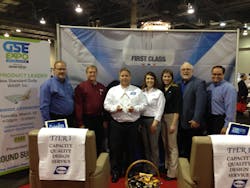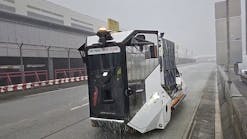WASP's New Standard Dolly: 2015 Ground Support Product Leader Of The Year
Anyone looking for a dose of enthusiasm about the future of the GSE industry couldn't have done any better than to visit Booth 409 at our magazine's recent GSE Expo Worldwide trade show in Las Vegas last March.
At the WASP Inc. exhibit space, visitors could luxuriate in "First Class" treatment that included plush airliner seats and a buffet on both days. But even if creature comforts weren't enough, we left feeling positively upbeat after talking with the collection of company executives about sales within an industry that's weathered the economic worst and could be headed for better times ahead.
"I think airlines and others are finally getting ready to make some orders for new equipment that's meant to replace equipment that has been in service a very long time," says CEO Dane Anderson.
And not just "some" orders, but big numbers. While any sale is a good sale, WASP, like many othes GSE manufacturers, has had to make due with the spot buy of a truckload of equipment, say ten to 15 units, and in select areas to boot. Now the talk is turning to volume buying. As a result, WASP is gearing up with added manufacturing space and employees to meet a growing demand for larger sales in terms of 100 or 200 hundred units.
NEW STANDARD DOLLY
While the world’s largest manufacturer of non-powered GSE makes a number of pieces of equipment, we selected The New Standard Dolly as our magazine's Product Leader of the Year.
Due to the many types and combinations of containers and pallets it can handle, one New Standard Dolly can replace multiple dollies with various capacities. The result is greater efficiency for fleets.
"The New Standard Dolly is the result of a number of lessons we've learned over the years to make a reliable, high-quality product," says DeWayne Nelson, vice president of sales and who's been with the company for 20 years, "and specifically what our customers requested from the equipment."
It goes without that any type of GSE needs to be built tough. In the case of the dolly, it had to be strong enough to take the loads, but also withstand the punishment that of life outside on the ramp.
"From the information we gathered from site visits and customer input," says Kevin Hanson and a company veteran of 34 years, "we always heard a few disfferent items come up as focal point for any design changes we were going to make going forward."
Those concepts "commonality," "multi-function," and "mixed fleet," all come down to versatility and durability of the New Standard Dolly.
VERSATILE, DURABLE
The New Standard Dolly has a 15,000-pound (6,804-kilogramg) capacity and the versatility to carry LD-2, LD-3, LD-4 and LD-11 containers, as well as two LD-2 or LD-3 containers at a time. It also takes half pallets, 88-by-125-inch (224-by-318-centimeter) pallets and 96-by-125-inch (244-by-318-centimeter) pallets. LD stops and vertical restraints throughout the unit firmly lock containers in place.
The unit’s heavy-duty steel frame, Grade 5 zinc hardware and 69 high-load-capacity casters minimize in-the-field failures. Drain holes in the steel decking on either side of every caster allow water to travel through rather than collecting and tarnishing or freezing and obstructing the casters. The formed decking is boxed to make the unit as strong as possible.
Tineways between the casters allow forklift operators to place containers and pallets on the dolly and remove them. If needed, the tineways double as a non-slip walkway so operators can safely walk on the dolly to push containers.
WASP’s integrated towbar is spring loaded to prevent it from hitting the ground when dropped. Dual springs provide stronger holdup to prevent injury and extend the life of the towbar. To prevent damage to the tie rod, WASP lines it with a protection tube that is less expensive to replace than the part itself. The rollers have Zinc Flo-Coat® tubing to prevent rusting and rugged, high-capacity, sealed ball bearings. Roller guards protect the rollers on the perimeter of the dolly. The unit also is equipped with towbar-actuated rear brakes.
The dolly features radial-cut corners that reduce the potential for damage when the dolly strikes other dollies, trailers or equipment. WASP stamps indents into the channel for recessed placement of reflectors to prevent damage upon contact with another object. U.S. military-grade powder-coated finishes keep the New Standard Dolly looking new. Custom colors are available. Optional hot-dip galvanizing can further protect the dolly.
Like all of its equipment, WASP builds the New Standard Dolly with premium components, specialized manufacturing equipment and welds by certified welders. The company also conducts rigorous quality testing, such as washboard-track testing, to ensure durability, long life, and the lowest total cost of ownership in the GSE industry. In addition, WASP designed the New Standard Dolly with numerous features that further enhance reliability and safety.
QUICK TURNAROUNDS
WASP optimized the industrial design of the New Standard Dolly for its manufacturing process so it can build the equipment with more stock steel sizes and components and reduce labor costs. Because of that, the company can manufacture and hold units in inventory for quick fulfillment.
While much of this standardization is a plus to a manufacturer, this quick turnaround time to make and ship orders to just as much a benefit to customers these days.
"The added value to all the ideas that went into creating the New Standard Dolly is that one piece of equipment can take care of all the container sizes that very common in the industry," Hanson explains, "and by making this a common design we can now have rolling stock and can react to short lead times for orders."
That standardization is a vital key to supplying customers these days.
"Probably one of the biggest driving factors is that a ground service company has to have all the required equipment within 30 to 45 days after they've picked up a new contract for business," Nelson adds. "That lead time is considerably shorter than it used to be."
For a manufacturer, there could easily be two weeks cut from this time frame after the customer selects the vendor. That can give WASP less than a month to deliver the order.
In addition, the New Standard Dolly can be stacked five high to save space on trucks or in overseas containers during shipping and reduce shipping costs. The bottom dolly retains its functionality, so the stacked dollies have roll-on/roll-off capabilities for transport without crating. An extension pipe fits through the shipping brackets on each corner of the dolly to take weight off of the deck and tires during transport.






